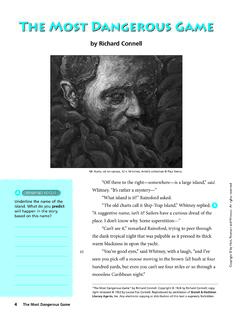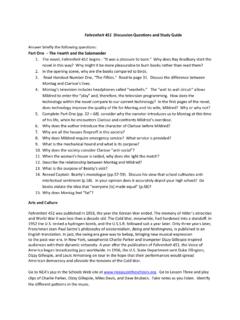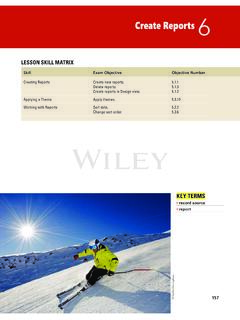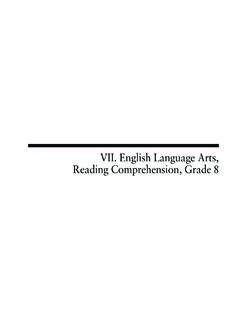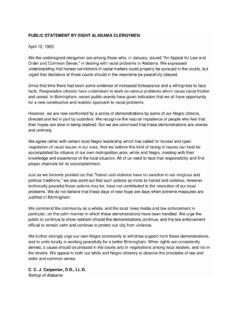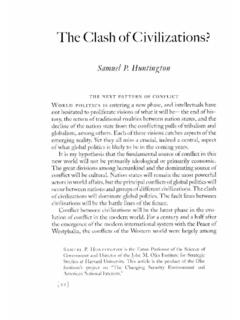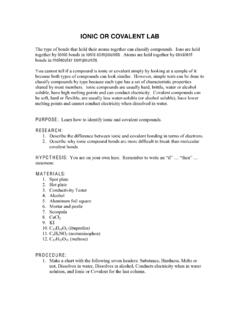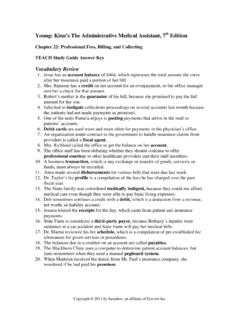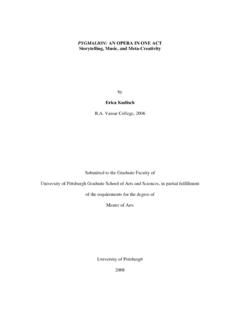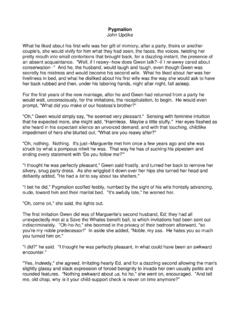Transcription of PYGMALION - Quia
1 PYGMALION Metamorphoses From the beginning of time it would seem, at least from the male tive, man has quested for, and even sought to create, the perfect Vi: Robotics produced The Stepford Wives, Frankenstein stitched together a b . his monster, and Professor Henry Higgins fashioned his "fair lady" fro raggedy flower girl, Liza Doolittle, in Lerner and Loewe's delightful m an adaptation from George Bernard Shaw's PYGMALION . But Ovid, Shaw'~ _ ultimate inspiration and our principal ancient literary source for the tale. provided us with a far more miraculous transfonnation. Offended b. profligacy of the daughters of Propoetus (who, for their impiety, were formed by Venus into prostitutes and then hardened into stone), the Cyp sculptor PYGMALION withdrew from all contact with women, living the life celibate and dedicating himself wholly to his art. Eventually he sculpted an . statue of a maiden more beautiful than any ever born, and then promptly L love with his own creation. The central panel of Ovid's narrative focuses in d on the artist's elegiac (and to some extent ritualistic) courtship of his i maiden and then, when the festival of Venus had arrived, on his prayer to.
2 Goddess that his own wife might be, if not the statue itself, then at least a wo in her likeness. In return for his piety, Venus grants PYGMALION 's wish, revers' ..; both the process by which she had transformed the impious Propoetides and . - _ usual (human to sub-human) direction of metamorphosis in Ovid's poem: as sculptor kisses his "Sleeping Beauty," her skin grows warm and soft, her ve begin to pulse, a blush comes to her face (unlike the bloodless, shamel Propoetides), and she raises up her eyes to glimpse at once the light of bea and her lover's gaze. Despite the unnatural inception of their affair, and und the benign guidance of Venus, the two are wed and soon have a daughter Paphos, who (in an etiological aspect of the myth) gave her name to a ciry Cyprus famous for its cult of the goddess. It is little wonder that a story with these fairy-tale qualities, so sensuous sentimental, and so focused on artistic creation, should have inspired, not the talents of George Bernard Shaw, and Lerner and Loewe, but such an' (among many, many others) as Fa1conet, Rodin, and Gerome, whose 0 creations are pictured in the pages that follow.
3 "Fellow-artists," one ought say-for it was very much Ovid's point that we should see PYGMALION , merely as a man, but as a creative genius. In this role, PYGMALION shares ce qualities with Orpheus, which the reader is invited to explore, even as his ivo _ maiden has much in common with Ovid's Eurydice. To note only an obvi point or two, both men attempt to use their artistic talents to control ili . e male perspec perfect woman. ~erher a bride for lady " from the Ilightful musical, 1id , Shaw's own fo r the tale, has )ffended by the iety , were trans e) , the Cypriote -ing the life of a sculpted an ivory promptly fell in ~ focuses in detail ;hip of his ivory his prayer to the ~ a l least a woman wish, reversing 'opoetides and the . " s poem: as the ind soft, her veins ocUess, shameless light of heaven . affair, and under have a daughter, name to a city of '" so sensuous and inspired, not only , but such artists e, whose own sts," one ought to PYGMALION , not lion shares certain even as his ivory e only an obvious ts to control their women: the one fails, despite the magical charm of his music.
4 Spouse to life; the other succeeds, through piety and the power of an, in his ideal woman to life. The wives themselves are one-dimensional, manipul Eurydice's role is but to die, and die again, uttering only an uncomplaining "farewell"; the ivory maiden, who speaks not even a single word and has no name (though in postc!assical adaptations she is called Galatea), is shaped , and handled , and, when brought to life, gazes heavenward at her creator as at a god. With these points in mind , along with the condemning attitudes about the virtue and beauty of "real " women that are expressed early in the narrative, some readers view PYGMALION in a negative light, as an eccentric misogynist and a manipulator. But the story's misogyny is perhaps better attributed to the persona of its narrator, Orpheus himself, who in mourning the death of Eurydice has gone on to reject all other women and is here singing (hence the quotation marks enclosing the text below) one of a series of ballads protesting their vile and illicit loves.
5 PYGMALION 's religious devotion to Venus is remarkable, as can be seen from her extraordinary intervention on his behalf, and , in the intensity of his reverence for his beloved, he is certainly nearer to Pyramus than to Ovid's Apollo or even to Orpheus: in the end , it may be that the poet expects us to fault PYGMALION for nothing more than the extremity of his idealism. In his role as artist in fact, and in particular as an artist of the erotic, PYGMALION has much in common with Ovid himself. Both the poet and PYGMALION (who is at once a creator and the poet's own creation) revere love, and beauty, and the illusion of reality . It has been observed that Ovid's comment on the realism of PYGMALION ' s statue-ars adeo latet arte sua ("so utterly was his artifice concealed by his art")-might well serve as a prime tenet of the poet' s own philosophy of art. " PYGMALION and Galatea " Auguste Rodin, 1889 Metropolitan Museum of Art New York 78 ~ OVID: LOVE AND TRANSFORMATION 238 Sunt.
6 Ausae: the opening line is neatly symmetrical, with Venerem at the axis, surrounded by obscenae .. Propoetides, and verbals framing the whole; the sentence's prose order would be Tamen Propoetides obscenae ausae sunt negare Venerem esse deam. tamen: , ignoring the fate of their compatriots, the Cerastae, whom Venus had transformed into bul1s for butchering their guests-a story told by Ovid in the preceding passage. obscenus, -a, -urn, ill-omened; filthy, loathsome; lewd. obscenae .. ausae: Ovid likes to arrange pairs of end-rhyming and grammatically connected words such as these two by setting one at the caesura, with the last syl1able under the ictus, and the other at line' s end; the effect is to accentuate both the connection and the assonance (cf. above). Propoetides, Propoetidum, f. pI., the Propoetides (daughters of Propoetus of Cyprus, who were, according to this legend, the first prostitutes). 239 pro quo: this offense. sua .. / corpora cum forma (240): a kind of hendiadys; we would say simply their beautiful bodies.
7 Ira: abl. of cause. 240 primae .. feruntur: sc. esse, they are said to be the first. vulgo, -are, -avi, -atus, to make available to the masses; to prostitute (vulgiisse = vulgavisse). 241 '" pudor, pudoris, m., sense of shame; decency, chastity. sanquisque indiiruit oris: Ovid imaginatively blends the physiological with the psychological-when we are ashamed, blood rushes to our faces and we blush, but when we cease to feel shame and to blush, it is because the blood has hardened in our veins. indiiresco, indiirescere, indiirui, to grow hard, harden, set. 242 rigidus, -a, -urn, rigid, stiff; unyielding. parvo .. discrimine: with little rwticeable change, , from their former nature as "hardened" prostitutes; abl. of attendant circumstance. "'silex, silicis, m., hard stone, flint (often used of the absence of emotions, or "hard-heartedness, " in persons-cf. Am. below). versae: sc. sunt. 243 Quas: = Eas (with agentis). quia , conj., since, because. "' PYGMALION , Pygmalionis, ffi.
8 , PYGMALION (legendary king of Cyprus, though here seen only as a sculptor). aevum, -i, n ., time, age; aevum agere, idiom, to spend one 's life, live. per crimen: here, in wickedness, viciously. 244 offensus, -a, -um, offended, shocked. v itiIs , quae pliirima: English would take the adjective with the noun rather - than the pron., the countless vices which.. 245 sine coniuge caelebs / vivebat .. consorte carebat (246): the second clause intensifies the first; note the harsh c alliteration at the end of hoth '~th Venerem at the Ibals framing the I)Oetides obscenae ~tae, whom ~ts-a story told Ill-rhyming and ~. setting one at the other at line's the assonance of Propoetus foosti tutes). -~'e would say ~.. to p rostitute s iological with to our faces and we because the Stl. "Sunt tamen obscenae Venerem Propoetides ausae esse negare deam; pro quo sua, niiminis Ira, 240 corpora cum ronna prImae vulgasse feruntur, utque pudor cessit sanguisque indiiruit oris, in rigidum parvo silicem discrImine versae.
9 "Quas quia PYGMALION aevum per crImen agentTs vIderat, ofrellSus vitus, quae plUrima mentT 245 remineae natUra dedit, sine coniuge caelebs vIvebat thalamIque diu consorte carebat. Interea niveum mIra rellciter arte sculpsit ebur ronnamque dedit, qua remina nascI Discussion Questions 1. In 241-42 Ovid wants his readers to visualize the actual metamorphosis of the Propoetides, but how might the incident and the transformation also be viewed metaphorically? 2. Comment on the word order, and its effect, in 242. 3. What is your response to PYGMALION 's actions, and his motivations, in 243-46? Is the characterization of woman's nature (244-45) PYGMALION 's, the narrator's ( , Orpheus'), or Ovid's? from their former :ilSt8nce. ICe of emotions, or of Cyprus, though rme's life, live. th the noun rather VJ: the second 11 the end of both feet tense verbs. caelebs, caelibis, unmarried, celibate. thalamus, -I, m., inner chamber; bedroom. consors, consortis, , one who shares with another; a partner, consort, companion.
10 Carro, carere, carui, caritiirus + abl., to lack, be without . _~7 niveum mira feliciter arte / .. _ ebur (248): the ABCBA arrangement-with the epithets first, and the nouns suspensefully delayed-is as "felicitously artful" as the sculpture Ovid describes. The full significance of mira becomes apparent as the tale unfolds (cf. mlratur 252) . sculpO, sculpere, sculpsi, sculptus , to carve, sculpt. sculpsit ebur, fOrmamque dedit: another chiasmus. qua: (beauty) with which, abl. of description. qua femina nasci / nulla (249): the alliteration and assonance add a delicate sound effect. 80 ~ OVID: LOVE AND TRANSFORMATION 249 operis .. sui: objective gen. with amorem (cf. simulati corporis ignes 253). *concipiO, concipere, concepi, conceptus, to receive; to conceive. develop; to express or compose (in words). 250 quam: subject of both vivere and velie in the indirect statement after crediis, which you would think was alive and wanted to move; the 2nd-pers. verb serves to involve the audience.
